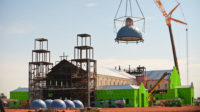Not so “alternative” anymore is one way to describe the rise of alternative project delivery. Revenue for construction management-at-risk and design-build delivery reached all-time highs before COVID-19 plagued the market. But this year’s company rankings tell a more complicated story about alternative project delivery during a crisis.
Over the last 10 years, before the pandemic, alternative project delivery firms reaped the rewards of a rapidly expanding construction market—cementing the boom that many firms reported in their ENR Top List surveys. Total revenue for construction management-at-risk (CMAR) projects peaked in 2019 at $151.92 billion before the virus took hold last year and brought it down slightly to $148.3 billion.
Total design-build revenue rose to a crescendo in 2018 at $107.65 billion and was also on track to peak in 2019. But Fluor Corp., ranked at No. 2 in 2018 at $10.96 billion, did not participate in last year’s survey due to internal financial audits. As a result, the design-build revenue total took a dip in 2019 to $96.78 billion and only slightly rebounded in this year’s list to $97.77 billion, which included the return of Fluor’s revenue figures.
|
Related Links |
Collectively, the 2021 Top 100 alternative project delivery firm rankings reflect the mindset of many owners during the early stages of the pandemic. Many scaled down and pivoted to traditional design-bid-build approaches on smaller, turnkey projects because that was what many contractors know best, firms have reported. A few firms that fell off the list this year also reported taking more design-bid-build work when alternative project delivery projects slowed down.
Adapting to market conditions and the needs of clients kept many firms’ revenues strong while they navigated changes brought on by the pandemic.
Pandemic Pivot
The pivot by some firms to design-bid-build had an immediate impact on their alternative project delivery revenue, in some cases dropping them off the Top 100 Design-Build and CMAR lists. As a result, there are more than 15 newly ranked firms on each list.

“There is no secret that the industry is experiencing pockets of significant material price escalation and supply chain disruptions.”
-Matt Ralston, Senior Vice President, Burns & McDonnell
With Fluor back in the fold for 2021, Top 100 Design-Build list revenue grew just under 1%. But losing McDermott International—since it did not participate after entering and exiting bankruptcy protection in 2020—removed a reported $8.4 billion in revenue from the total. Kiewit increased design-build revenue by more than $2 billion to reach the No. 1 spot for the first time after consistently ranking in the top five for years. Meanwhile, Bechtel dropped nearly $3 billion in revenue to No. 2, most likely the result of a shrinking cost structure previously reported by ENR.
Overall, median design-build firm revenue rose to $499 million from $494.85 million on last year’s list, up 0.8%. When it comes to overall general contracting revenue, design-build has shrunk to 24.4% last year, from 29.1% in 2016, according to ENR data.
Based on reported revenue on the Top 100 CMAR delivery list, the total shrank 2.4%, mostly on the domestic side. But international revenue trends clearly show a more gradual decline. CMAR continues to hold a large overall share of general contracting revenue, from 34.3% in 2016 (among all firms who sent in surveys) to 41.6% this year, still down from its peak of 43% in 2019.
The median firm revenue for CMAR was $776.3 million, a 10.8% drop from last year’s $870.1 million figure. Of the 41 survey respondents that listed 100% of general contracting revenue from CMAR (including firms ranked below the Top 100 threshold), 36.6% said their backlog was higher than last year, 29.3% said it was lower and 29.3% reported no change. Those backlog percentages for all firms on the Top 400 Contractors list were 43.7%, 38.2% and 18.1%, respectively.
In written survey responses, firms reported that owners are looking for ways to restore certainty to a market suffering under the unpredictability of the COVID-19 crisis. Early cost and schedule certainty is ultimately what many clients want, says Matt Ralston, senior vice president in the construction/design-build group at Burns & McDonnell.
“There is no secret that the industry is experiencing pockets of significant material price escalation and supply chain disruptions, including increased lead times and freight costs as well as unpredictability of imported equipment and materials,” he says. “A big challenge for us this year will be mitigating those risks and supply chain constraints.”
Alternative Insights
Even in previous years of major growth for alternative project delivery, the construction industry was still in the throes of another dilemma caused by workforce shortages. Contractor backlogs brimmed while labor scarcity pressurized the bid-build process, many contractors reported. Under these heightened conditions, owners become more open to innovation in the form of alternative project delivery systems, explains Mounir El Asmar, associate professor in the School of Sustainable Engineering & the Built Environment at Arizona State University’s Del E. Webb School of Construction. After an initial contraction, crisis-level market conditions caused by the pandemic might again push owners toward innovation to lift shelved projects into production, he says. But firms will need to prove to owners that alternative project delivery works in a crisis.
One clear advantage that alternative project delivery has over traditional design-bid-build is that project design often does not need to be completed to start construction. The “overlapping of design phases with some of the construction phases” is a critical component of CMAR, design-build, integrated project delivery and many other alternative delivery methods, says El Asmar. “The other piece that is so critical is the contractor can provide input on the design,” he says. “They can perform constructability analyses and estimate the cost and schedule impacts of design decisions to inform the design in a way that leads the final product to be a lot closer to what the owner intends for the budget.”
The up-and-down revenue of Top 100 firms isn’t surprising, says El Asmar. It reflects the natural ebbs and flows of owners investing in alternative project delivery.

“Because contractors are grounded in the reality that labor is scarce, and steel and other construction materials costs are through the roof, they have a good pulse on prices in the construction market.”
-Mounir El Asmar, associate professor, Arizona State University
In one research study measuring the scope of the approaches, ASU found that CMAR and design-build projects tend to be of larger size and complexity, since the amount of up-front investment requires the owner to hire the alternative delivery team early on.
Owners “are going to compensate them … for that time, effort and insight into the design that the contractor is bringing on,” says El Asmar. “That’s generally the case on complex projects with room for innovation. You want contractors to join the party early and develop solutions with you.” For some firms, he explains, 10 alternative delivery projects could account for as much as 50% of revenue while about 50 design-bid-build projects could account for the other 50%.
Additionally, alternative project delivery is often the faster method because contractors help navigate market conditions early on. “There are good studies out there that show that design-build and CMAR can be twice as fast as your traditional design-bid-build,” says El Asmar. “Because contractors are grounded in the reality that labor is scarce, and steel and other construction material costs are through the roof, they have a good pulse on prices in the construction market.”
They then can use that insight to be sure the project takes the owner’s budget into consideration. “They can relate that to the designer to take it into account so they can design the project to the owner’s budget,” El Asmar points out.
As an integrated engineering, procurement and construction provider, Burns & McDonnell says it has the ability to drive construction jobsite conditions during design, minimizing labor risks and increasing predictability for stakeholders, which has helped it solve labor and workflow issues during the pandemic.
“When craft availability is limited, strategic use of off-site prefabrication and modularization is effective in driving down the peaks in personnel demands, eliminating trade stacking and minimizing overall field construction hours, all of which improve safety, quality and productivity,” says Burns & McDonnell’s Ralston. “Having the flexibility to self-perform construction, both in open shop and union spaces using our wholly owned subsidiaries Ref-Chem and AZCO, respectively, provides further direct control over the skilled labor and eliminates insolvency risks that exist in the construction sector.” This helped the firm expand its capacity in power generation, oil, gas, chemicals, electrical transmission and distribution markets, as well as in process and manufacturing.
Companies further report reorganizing their portfolios to better meet developing business markets. For example, Black & Veatch is preparing for an ongoing energy transition that it calls “repowering” the power industry.
“We’ve rewired our entire power business to be broader in renewables and distributed energy,” explains Mario Azar, president of Black & Veatch’s power business. “We’ve introduced more focus on smaller power transmission and distribution solutions, and we’re actively engaged in hydrogen as a clean fuel alternative for power generation.”
Infrastructure in Flux
With a trillion-dollar proposed infrastructure spending bill launched by the White House in the form of the American Jobs Plan, alternative project delivery could be poised to take a major piece of the post-pandemic contracting market share.
Public agencies need legislative authority to engage in design-build delivery, and currently 45 states, plus the District of Columbia, either widely or fully permit design-build delivery (see chart, p. 46), says Lisa Washington, CEO of the Design-Build Institute of America.

“We saw a lot of legislative activity during COVID, and it’s been that way for many years in a row. What that means is that we continue to have broad authority in the majority of the country.”
-Lisa Washington, CEO, Design- Build Institute of America
“We saw a lot of legislative activity during COVID, and it’s been that way for many years in a row,” she says. “What this means is that design-build is a tool in the toolbox for public agencies across the country.” Washington notes that “as an organization, we believe that having the option to consider design-build as a project delivery method is important, but it may not be right for every project.” A lot depends on project goals and what the owner wants to achieve, she adds.
Overall, firms should prepare to meet their backlog of work. “Our member firms have, pretty unanimously, indicated that they are very busy, and we do believe that there is going to be a backlog of projects that need to be completed post-pandemic,” says Washington, predicting contractors will be busier than designers because many projects that broke ground only to be shelved last year have restarted.
“We truly believe that, very similar to the American Recovery and Reinvestment Act, these [infrastructure] projects are going to come with some stipulations about getting them off the ground quickly,” Washington adds, “and we think design-build is going to play a major role in that.”







Post a comment to this article
Report Abusive Comment